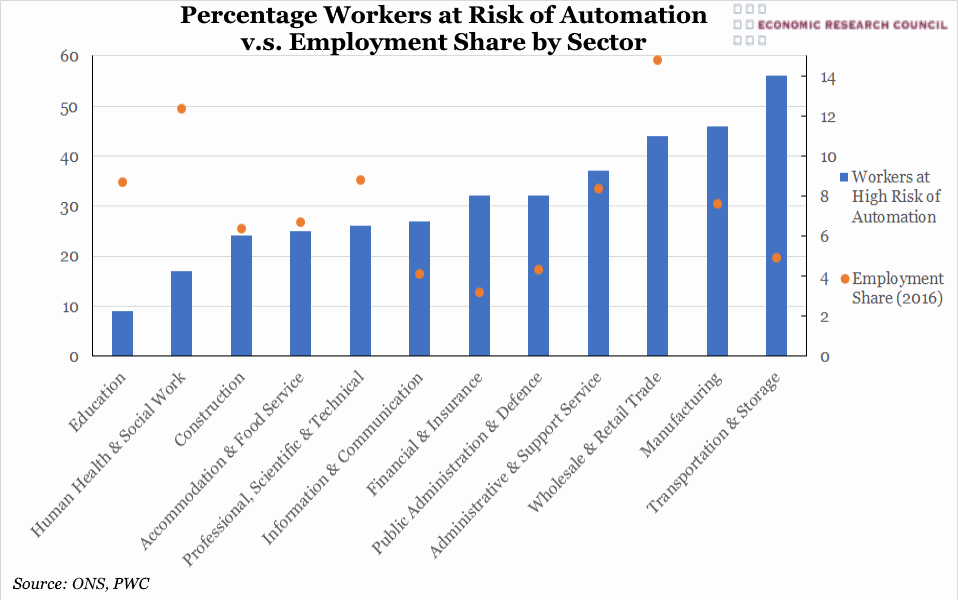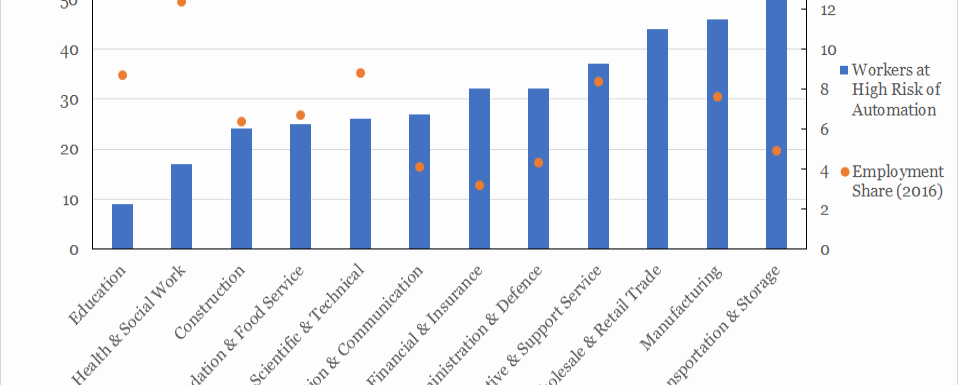
Summary
This analysis suggest that up to 30% of UK jobs are considered to be at high risk of automation by the early 2030s. This places fewer UK workers at risk than in the US and Germany where the figures are 38% and 35% respectively, but the UK fares worse than Japan (21%). The sector with the highest risk is manufacturing where the report estimates that 46.4% of workers could be at risk. When considering the share of total employment within manufacturing, this translates to 1.22 million jobs. Although wholesale and retail trade enjoys a lower percentage of workers at risk, as it represents nearly 15% of total employment, the number of workers at risk is nearly double those in manufacturing, at 2.25million. In the health, care and education sectors, there is a markedly lower risk to workers, and is projected to affect less than 1 million workers.
What does the chart show?
The blue bars represent the percentage of workers from each sector whose jobs are at high risk of automation by the early 2030s, measured against the left hand axis. This data has been drawn from a report by a consultancy who used previous studies and data from the OECD’s Programme for the International Assessment of Adult Competencies (PIAAC) to estimate whether or not jobs were automatable. It is worth considering that other studies in this area have found quite divergent results; notably Frey and Osborne in 2013, whose estimates are slightly higher as well as a 2016 study by the OECD whose estimates are far lower. This study, unlike the two prior, attempts to take into account potential job creation through automation as well as accounting for limits of job automation that are separate to what technology permits. The orange dots show the percentage of total employment in the UK in each sector. It is measured against the right hand axis and uses ONS data for 2016.
Why is the chart interesting?
There has been much talk of automation as a solution to labour market shortages. One example came in February 2017, when Secretary of State for Environment, Food and Rural Affairs, Andrea Leadsom, addressed the National Farmers Union annual conference, stating that the solution to concerns about the potential exodus of EU workers lay in new technology and automation that would ‘complement the workforce’. However the data on automation displayed here suggests that only 18.7% of jobs in the category of agriculture, forestry and fishing have a high probability of becoming automated (which translates to 130,000 actual workers). EU workers make up some 90% of all seasonal agricultural workers according to the Association of Labour Providers, which also reported that there had been a dramatic dip in applicants for these seasonal positions in 2016. They attributed this to several factors; the post-referendum devaluation of the pound, which negated the introduction of National Living Wage for migrant workers, and the reported rise in anti-immigrant sentiment, both of which make other countries increasingly attractive to low-wage migrant workers.
Education is a significant differentiator in the risk to workers from computerisation. Those working in jobs that require only GCSE level qualification are at almost four times higher probability of losing out to automation compared to university graduates.
Two important caveats to this data exist: though possible, not every job that can be replaced through computerisation will be as other regulatory and legal factors may come into play; and should some level of automation occur, there would likely be wealth-generating productivity gains which could support job expansion in less automatable areas.

